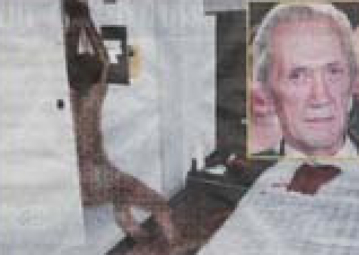

On 6th June, the sensationalist Thai Rath (ไทยรัฐ) newspaper published, on its front page, a photograph allegedly showing David Carradine’s body at the scene of his death. (His body had been discovered in his hotel wardrobe two days earlier.)
The image was partially censored, with a black moire pattern added to cover the body. (Incredibly, this pattern has led some international news sources, who have clearly not seen the photo, to claim that Carradine died wearing fishnet stockings.) The same image was also printed on an inside page with only slight pixelation.
Since the photograph was published, Carradine’s family has threatened legal action against any subsequent reproduction. Consequently, no other publication has printed the image, and it has been removed from Thai Rath’s website.
There is some speculation that the image is a fake, as it appears to show a relatively young man with black hair. But the position of the corpse is consistent with police reports that Carradine was discovered hanged and tied up in an apparent act of auto-erotic asphyxiation. Several unquestionably genuine photographs taken after Carradine’s autopsy have appeared online, though they have not appeared in any print publications.
Thai Rath is notorious for its crime-scene photographs. Perhaps the first was in 1961, when it published a photo of the body of a female student who had been raped and murdered. That image has rarely been reproduced, though it does appear in ๔ ทศวรรษภาพข่าวไทย (‘40 years of Thai photojournalism’).
The image was partially censored, with a black moire pattern added to cover the body. (Incredibly, this pattern has led some international news sources, who have clearly not seen the photo, to claim that Carradine died wearing fishnet stockings.) The same image was also printed on an inside page with only slight pixelation.
Since the photograph was published, Carradine’s family has threatened legal action against any subsequent reproduction. Consequently, no other publication has printed the image, and it has been removed from Thai Rath’s website.
There is some speculation that the image is a fake, as it appears to show a relatively young man with black hair. But the position of the corpse is consistent with police reports that Carradine was discovered hanged and tied up in an apparent act of auto-erotic asphyxiation. Several unquestionably genuine photographs taken after Carradine’s autopsy have appeared online, though they have not appeared in any print publications.
Thai Rath is notorious for its crime-scene photographs. Perhaps the first was in 1961, when it published a photo of the body of a female student who had been raped and murdered. That image has rarely been reproduced, though it does appear in ๔ ทศวรรษภาพข่าวไทย (‘40 years of Thai photojournalism’).


